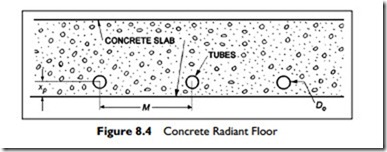Panel Heating and Cooling
The floor or ceiling of the space can be used as the heater or cooler. A floor that uses the floor surface for heating is called a radiant floor.
The radiant floor is heated by small-bore plastic piping that snakes back and forth at even spacing over the entire area that requires heating. The output can be adjusted from area to area by adjusting the loop spacing, typically 6 to 18 inches, and circuiting the pipe loop. Typically the water is supplied first to the perimeter, to produce the higher output at the perimeter.
The acceptable floor surface temperature for occupants’ feet limits the output. You may remember from Section 3.4, on human comfort, that ASHRAE Standard 55 limited the floor temperature to a range of 66–84°F for people wearing shoes who were not sitting on the floor. The maximum temperature limits the amount of heat that can be provided by a radiant floor.
Though radiant floors are often more expensive to install than other forms of heating, they can be very effective and economical to run, since they do not generate significant thermal stratification. As a result, the system is very com- fortable and ideal for children and the elderly. Control is usually achieved by outdoor reset of water temperature and individual thermostats for each zone.
The system can also be installed in outside pavement by using an inhibited glycol (anti-freeze) mixture instead of plain water. This can be used to prevent icing of walkways, parking garage ramps and the floor of loading bays that are open to the weather.
Ceilings can also be used for heating and/or cooling. As noted in 3.4, when using ceilings for heating, care must be taken to avoid radiating too much heat onto occupants’ heads. For ceilings down at 10 feet, the maximum temperature is 140°F. This maximum rises to 180°F at 18 feet ceiling height. When cooling, you circulate chilled water, instead of hot water through the ceiling panel pipe. The water temperature must be kept warm enough to ensure that condensation problems do not occur. The temperature difference between the ceiling panel and the space is quite limited. This limits the cooling capacity of the ceiling sys- tem and effectively limits its use to spaces that do not have high cooling loads.
Typically, a metal ceiling tile has a metal water pipe bonded to it, so that the whole surface becomes the heat emitter. There are many designs; one is shown in Figure 8.5.
The system has the advantage of taking up no floor or wall space and it collects no more dirt than a normal ceiling, making it very attractive for use in hospitals and other places that must be kept very clean.
